Are you tired of constantly worrying about your car battery dying? If so, it’s time to discover the best solar car battery charger with overcharge protection. Not only will it keep your battery charged and ready to go, but it also harnesses the sun’s power, making it an eco-friendly choice.
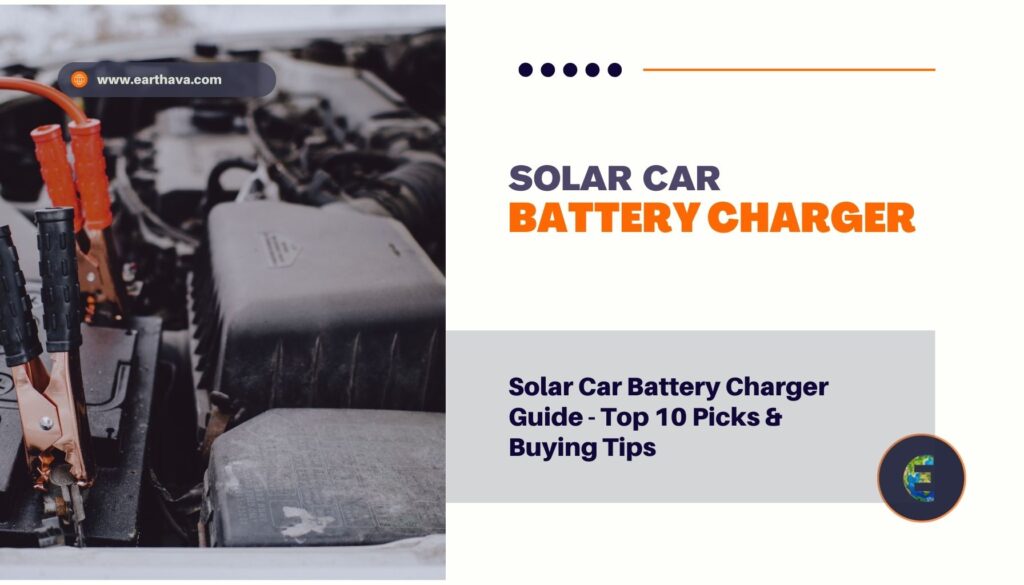
The solar car battery charger is designed to prevent overcharging, ensuring your battery remains in peak condition for longer. Its advanced technology automatically stops charging when your battery is fully charged, preventing any damage caused by overcharging.
By investing in this solar charger, you can embrace a more sustainable lifestyle while also saving money on electricity bills. You’ll no longer need to rely on traditional charging methods that drain energy and harm the environment. Instead, tap into the limitless power of the sun to keep your car battery charged wherever you go. Don’t let a dead battery slow you down. Upgrade to the best solar car battery charger with overcharge protection and enjoy the benefits of clean, reliable power on the road.
The market for solar car battery chargers offers a diverse range of models designed to provide convenient and sustainable charging solutions for vehicle batteries. This comprehensive review will showcase the top 10 solar car battery chargers, evaluating their efficiency, compatibility with different vehicle types, portability, and durability.
Whether you’re seeking a compact trickle charger for occasional use or a robust charger for off-grid adventures, this review will offer valuable insights to help you select the most suitable solar car battery charger for your needs. Embracing solar charging not only promotes eco-friendly practices but also ensures that your vehicle’s battery remains charged and ready to go, making it a practical and sustainable choice for car owners.
Top 3 Picks
🥇Renogy 10W Solar Trickle Charger
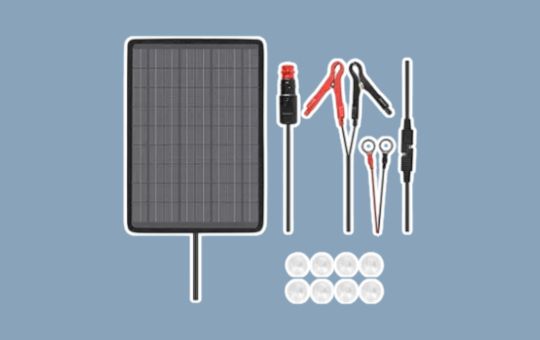
Summary
Renogy is a trusted solar brand, and this 10W charger delivers dependable trickle charging for cars, motorcycles, and boats. Great choice if you want reliability with minimal fuss.
🥈SOLPERK 50W Solar Charger Kit

Summary
SOLPERK delivers a higher wattage option for those who need more than a trickle, enough to maintain and recharge in sunlight. Larger than 10–20W models but worth it for more power.
🥉FlexSolar 20W Solar Panel Charger Kit

Summary
FlexSolar’s standout feature is its integrated controller, making it safer and easier to use for weeks at a time. Slightly less rugged than Topsolar, but more beginner-friendly.
Top 10 Best Solar Car Battery Charger Kits
1. OYMSAE 20W Solar Car Battery Charger
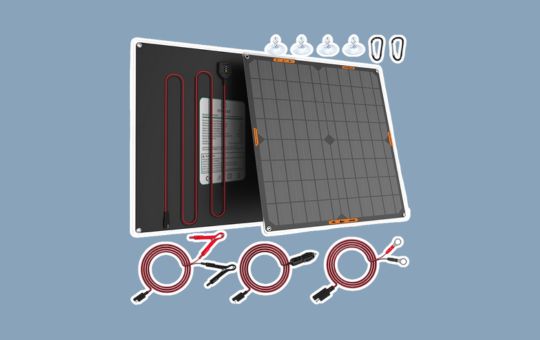
When people search for small solar panels online, especially the ones marketed for cars and boats, this OYMSAE 20W charger pops up often. It’s pitched as a portable, waterproof, all-weather solution for keeping a 12V battery topped up, whether that’s in a car sitting idle in the driveway, a fishing boat tied up at the dock, or even an RV in storage. The company calls it a “charger,” but based on specs and reviews, it’s technically more of a trickle maintainer than a full replacement for a plug-in battery charger. That distinction matters.
Specs and features:
- 20W monocrystalline solar panel (roughly 14 × 11 inches, fairly compact for what it is).
- Output: 12V DC, max current around 1.1A under ideal sunlight.
- Built-in charge controller to prevent overcharging, short-circuiting, and reverse current at night.
- Waterproof rating: IP65 (resists rain and dust, but not submersion).
- Comes with a 10ft cable, cigarette lighter plug, and alligator clips for direct battery connection.
- Designed for cars, motorcycles, boats, RVs, and small off-grid storage batteries.
What stands out, at least in our research, is the simplicity of the setup. Users mention that you can literally set it on your dashboard and plug it into the cigarette lighter socket (if the socket is live when the ignition is off), or clamp it directly to the battery with the included clips. No wiring headaches, no drilling brackets, it’s plug-and-maintain. For people who want “set it and forget it,” that’s appealing.
That said, the weak spot is pretty consistent in reviews: 20 watts is not enough for serious charging. In bright conditions, it produces about 1 amp of current. That’s fine to counteract parasitic battery drain over days or weeks, but if your car battery is already dead, this will not revive it. Many frustrated reviewers bought it expecting something closer to a jump-start solution. It’s not that.
Another detail worth pointing out: although the panel is waterproof, the little controller box attached to the cable is not completely sealed. Some boat owners noted issues with corrosion after prolonged outdoor exposure. The workaround, according to experienced users, is to keep the connections sheltered or add a small DIY cover.
Who’s this really for? Based on reviews, it’s best for people with seasonal vehicles, an RV parked most of the year, a boat that sits in the marina, or even a second car that doesn’t see daily use. It prevents the annoyance of finding a dead battery after weeks of sitting. It’s not a good match for anyone who needs to recharge a deeply drained battery quickly, or for heavy-duty off-grid power.
✅ Pros
- Straightforward setup with multiple connection options.
- Compact and lightweight, easy to store or move around.
- Works as intended for battery maintenance (trickle charging).
- Affordable compared to higher-wattage panels.
⚠️ Cons
- Cannot charge a dead battery, slow output by design.
- The controller box is not fully weatherproof.
- Performance drops sharply on cloudy days or behind glass.
- Marketing can be misleading; it’s a maintainer, not a true charger.
Earthava’s take: OYMSAE’s 20W panel competes with brands like ALLPOWERS or ECO-WORTHY in the same price range. Compared side by side, performance is similar, though OYMSAE tends to emphasize “waterproof” a bit more in its ads, something real-world users often push back against, saying it’s water-resistant at best. If you’re clear about what it can (and can’t) do, this little panel fills its niche well. Think of it less like a solar battery charger and more like a solar battery babysitter. It’s there to keep things alive, not bring them back from the dead.
2. Sunway Solar Car Battery Trickle Charger
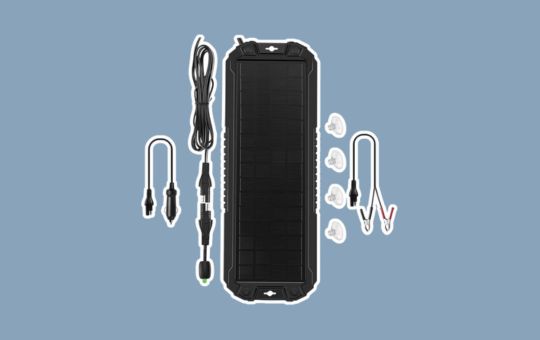
If the OYMSAE 20W panel is like a babysitter for your battery, the Sunway 5W version is more like the quiet night-light in the corner of the room. It’s tiny, low-power, and built to slowly offset parasitic drain on a 12V battery. Sunway markets this as a portable, waterproof charger for cars, RVs, boats, motorcycles, and even snowmobiles, but in practice, it’s really only suited for maintaining small batteries or keeping an idle vehicle from losing its charge over time.
Specs and features:
- 5W polycrystalline solar panel (about 8 × 12 inches, so compact enough for a dashboard).
- Output: ~15V peak, 330mA max current in direct sunlight.
- Includes a built-in blocking diode to prevent reverse discharge at night.
- Connects via cigarette lighter plug, battery clips, or O-ring terminals.
- Weather-resistant surface with a thin-film protective layer (not fully waterproof to submersion).
- Targeted for 12V batteries in cars, trucks, boats, RVs, motorcycles, tractors, and ATVs.
The standout feature here is actually its sheer portability. At under two pounds and no controller box to fuss with, users often just leave it on the dashboard or tuck it on the inside of a windshield. It doesn’t need constant babysitting, and the small size means it doesn’t get in the way. People who own motorcycles or boats seem to especially like it; it’s easier to stash than a bigger, framed panel.
But let’s be realistic: 5 watts is barely a sip of solar. At around 300mA max output, it’s not going to do much beyond slowing down the natural self-discharge of a lead-acid battery. If your car has power-hungry electronics running in the background (modern alarms, sensors, GPS units), this might not keep up. Several reviewers mentioned that in cloudy conditions or behind glass, the panel’s effectiveness drops to almost negligible. So, if your battery is already drained, don’t expect this little guy to rescue it.
Durability is a mixed bag. The panel itself has a scratch-resistant surface, but some users reported that the included suction cups (for mounting on a window) feel cheap and don’t hold up long-term. On the flip side, Sunway’s customer support gets decent marks, and replacement parts or refunds are handled fairly quickly, according to reviews.
Who is this for? In our research, it’s best for owners of smaller seasonal vehicles, motorcycles, lawn tractors, maybe an RV or boat during off-season storage, where you just need a trickle to prevent a flat battery. It’s not enough for someone wanting reliable year-round power for an RV or a car parked outdoors in cold climates.
✅ Pros
- Very compact, lightweight, and easy to position.
- Multiple connector options (lighter plug, clips, rings).
- Simple, no controller needed at this low wattage.
- Affordable and beginner-friendly.
⚠️ Cons
- Extremely low output; won’t revive a dead battery.
- Performance drops heavily behind glass or in shade.
- Accessories (suction cups, lighter plug fit) feel flimsy.
- Marketing leans heavily on the real-world power delivery.
Earthava’s take: Compared with similar trickle chargers (like ALLPOWERS 7.5W or ECO-WORTHY’s 10W panels), Sunway’s 5W version comes across as the entry-level option. It does its job in very light-duty situations but can’t compete with even mid-range wattages. if you need a tiny, no-fuss panel to keep a motorcycle or small vehicle battery from going flat while it sits, this fits. Just don’t expect miracles. Think of it less as a charger and more as a slow drip-feed of sunlight into your battery.
3. Renogy 10W Solar Car Battery Charger

Renogy is a familiar name in the solar world, usually associated with bigger, off-grid systems, so their 10W trickle charger feels like the brand’s “pocket-sized” offering. It’s aimed at maintaining 12V batteries in cars, boats, motorcycles, and trucks, and comes packaged as a portable kit with all the expected connectors. Unlike some of the budget brands, Renogy leans on its reputation here, marketing this panel as a more durable, reliable option for everyday battery maintenance.
Specs and features:
- 10W monocrystalline solar panel, compact and framed.
- Output: ~16–18V peak, 0.55A current in full sun.
- Built-in blocking diode to prevent reverse current at night.
- Connection options: cigarette lighter plug, alligator clips, or battery terminal rings.
- Weather-resistant surface, scratch-protected tempered glass.
- Designed for 12V batteries (cars, RVs, boats, motorcycles, tractors).
The standout feature, and what reviewers highlight most, is build quality. For a 10W panel, it feels sturdier than many of the ultra-light trickle chargers on Amazon. The tempered glass surface resists scratches, and the aluminum frame gives it a “real solar panel” feel rather than a flimsy plastic sheet. According to users, it holds up better outdoors than many of the cheaper, bendy designs.
But that durability doesn’t make it more powerful. At the end of the day, it’s still just 10 watts. Based on reviews, you’re looking at around half an amp of current on a good day, which is enough to slow or offset battery drain but not enough to recharge a dead battery. Several users note that the included cigarette lighter plug only works if the socket is active when the ignition is off; otherwise, you’ll need to use clips or ring terminals.
One small drawback flagged in reviews: there’s no built-in charge controller, which at 10W isn’t necessarily a dealbreaker (the current is low enough to avoid overcharging in most cases). Still, for long-term outdoor use on smaller batteries like motorcycles, a controller would give extra peace of mind. Renogy sells add-ons, but that raises the cost compared to some competitors who include basic protection in their kits.
Who’s this best for? Our research points toward people who care about longevity and sturdiness over sheer wattage. someone with a stored car, a boat moored for weeks, or a farm vehicle that sees intermittent use. It’s less suited to people looking for budget-only solutions or those needing something more powerful for RV systems.
✅ Pros
- Sturdy construction with tempered glass and an aluminum frame.
- Multiple connection options for flexibility.
- Reliable trickle charge for stored vehicles.
- Trusted brand in solar products.
⚠️ Cons
- Limited output, cannot recharge a dead battery.
- No built-in charge controller.
- A cigarette lighter plug may not work in all vehicles.
- Pricier than some 10W competitors.
Earthava’s take: Compared with Sunway’s 5W panel or the budget 7.5W options, Renogy’s 10W strikes a balance: not the cheapest, not the most powerful, but probably the most solidly built in this range. If you want something you can leave out in the weather without worrying it’ll warp or crack, Renogy makes sense. Think of it as the “middle sibling” in the trickle charger family, more muscle than a 5W, more trustworthiness than the no-name brands, but still capped by the reality of 10 watts.
4. Voltset 30W 12V Solar Panel Kit with MPPT Controller
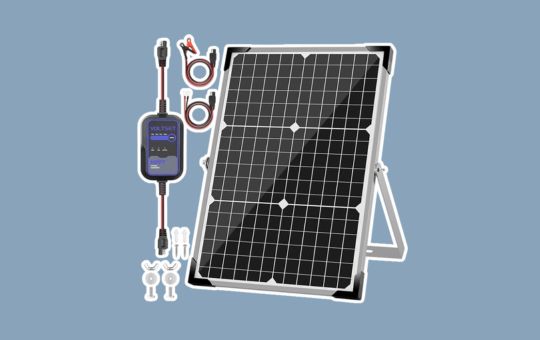
Step up from the tiny trickle chargers, and you land in the 30W range. like this Voltset kit. It’s marketed as a “solar maintainer,” but with 30 watts and an included MPPT controller, it has more teeth than the smaller 5W or 10W panels. In simple terms: this isn’t just to keep a battery from going flat; it can actually put back a decent amount of charge if the battery isn’t too far gone. That makes it stand out in a lineup where many “trickle chargers” barely sip sunlight.
Specs and features:
- 30W monocrystalline solar panel with waterproof housing.
- Output: ~18V peak, ~1.6A max current in strong sun.
- High-efficiency MPPT charge controller included (boosts charging efficiency vs. basic PWM).
- Connection options: alligator clips, ring terminals, direct wiring.
- Adjustable mounting bracket for optimal tilt.
- Designed for 12V lead-acid and lithium batteries (cars, boats, motorcycles, RVs, tractors, and more).
The standout feature here is clearly the MPPT controller. Most budget solar maintainers skip this, but an MPPT (maximum power point tracking) controller actively adjusts the panel output to extract more usable power. In practice, that means more consistent charging, especially on cloudy days when light fluctuates. According to user feedback, the efficiency bump is noticeable, the Voltset kit tends to outperform similar-wattage panels with simple PWM regulators.
But it’s not flawless. One drawback flagged in reviews is the bulkiness of the mounting system. The panel itself is compact for 30W, but the included bracket, while helpful for angling toward the sun, adds extra weight and makes it less “portable” compared to a simple dashboard panel. Some users also noted that while the panel is waterproof, the controller needs to be kept dry, which means either housing it indoors or DIY weatherproofing.
Who’s this for? Our research suggests it’s best for people who actually need more than maintenance, RV owners in storage lots, boat owners who can’t plug into shore power, or anyone who wants to trickle charge a larger battery bank (like deep-cycle marine or AGM units). For motorcycles or lawn tractors, it’s probably overkill.
✅ Pros
- Higher wattage (30W) means faster charging than 5–10W models.
- Includes MPPT controller for better efficiency.
- Adjustable bracket helps maximize sunlight capture.
- Works with both lead-acid and lithium 12V batteries.
⚠️ Cons
- Less portable, bulkier with bracket and controller.
- Controller not fully waterproof.
- More expensive than smaller maintainers.
- Can be overkill for small batteries.
Earthava’s take: Compared to lower-wattage models like Renogy’s 10W or Sunway’s 5W, Voltset’s 30W kit feels like a serious upgrade. It bridges the gap between a casual maintainer and a small off-grid panel. Still, it’s important to remember: 30W is useful, but it’s not going to run appliances or fully charge a deeply discharged RV battery overnight. Think of it as a smart, efficient way to keep a healthy battery strong, with the bonus of a little extra recharge capability.
5. ECO-WORTHY 10 Watt Solar Car Battery Charger & Maintainer
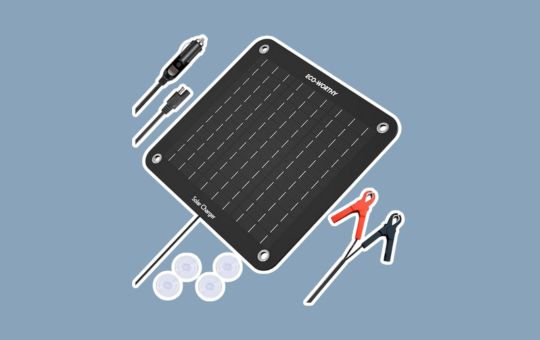
ECO-WORTHY is one of those budget-friendly solar brands that’s everywhere online, from full off-grid kits to little trickle chargers. Their 10W model sits right in the sweet spot for people who want more oomph than a 5W panel but don’t need the bulk (or price tag) of a 20W or 30W setup. It’s designed to maintain 12V batteries in cars, trucks, boats, RVs, lawn mowers, ATVs, and tractors, basically anything that risks going flat after sitting idle.
Specs and features:
- 10W polycrystalline solar panel with tempered glass surface.
- Output: ~16–18V open circuit, 0.6A max current in full sunlight.
- Built-in blocking diode to prevent reverse current discharge at night.
- Weather-resistant and waterproof design (IP65 rating, fine with rain but not full submersion).
- Includes cigarette lighter adapter, alligator clips, and battery ring terminals.
- Lightweight (about 2 lbs), framed panel for outdoor or dashboard use.
The standout feature here is value for money. According to reviews, it’s one of the more affordable 10W panels that still feels solid enough to leave outdoors. The glass and frame construction make it sturdier than the ultra-thin, film-style chargers that scratch or warp. Users mention it holds up decently through seasonal use on boats and tractors without feeling disposable.
But the trade-off: no charge controller. At 10W, the risk of overcharging is low for larger vehicle batteries, but for small ones (motorcycles, lawn tractors), reviewers recommend adding a controller if you’re leaving it connected long-term. A few users also noted the included accessories, particularly the suction cups for window mounting, feel a bit cheap and don’t last.
Who’s this best for? Based on reviews and comparisons, it suits people looking for a low-cost, set-and-forget battery maintainer. Ideal if you park a car or truck outside for weeks, keep a tractor in the barn, or just need to keep a boat battery topped up between uses. It’s not powerful enough to revive a dead battery, and it won’t support heavy off-grid use, but it covers the basics well.
✅ Pros
- Affordable price point for a framed 10W panel.
- Sturdy tempered glass design.
- Multiple connector options included.
- Reliable for slowing battery drain.
⚠️ Cons
- No built-in charge controller.
- Accessories (suction cups, plugs) feel flimsy.
- Output is limited, cannot recharge a dead battery.
- Performance drops in shaded or cloudy conditions.
Earthava’s take: Compared to Renogy’s 10W, ECO-WORTHY’s version is clearly the budget rival. It doesn’t have the same brand reputation or finish quality, but for the price, it gets the job done. If you need a no-frills, affordable way to keep a 12V battery alive during downtime, this panel makes sense. Just pair it with a controller if you’re cautious or using it on smaller batteries.
6. POWOXI 9W Solar Battery Trickle Charger & Maintainer
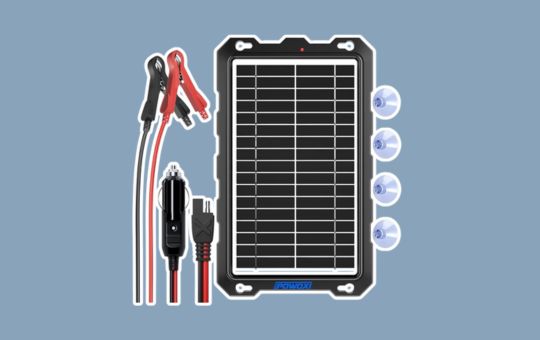
POWOXI isn’t a household name like Renogy, but their 9W solar maintainer has quietly become one of those popular Amazon picks for people who just want something simple and cheap to keep a battery alive. It’s marketed for cars, motorcycles, boats, RVs, trailers, and even snowmobiles, essentially any 12V battery that risks discharging when left idle.
Specs and features:
- 9W polycrystalline solar panel (compact and lightweight).
- Output: ~15–18V open circuit, ~0.5A max current in strong sunlight.
- Built-in blocking diode to prevent reverse discharge at night.
- Waterproof surface with PVC coating; panel sealed for outdoor use.
- Connection options: cigarette lighter adapter, alligator clips, and battery ring terminals.
- Weather resistance: rain- and dust-proof, but not submersible.
The standout feature is the balance of size and output. At 9W, it’s a little stronger than the common 5W trickle chargers (like Sunway’s), but still small enough to place on a dashboard or lay across a windshield. Based on reviews, many people buy this as a step-up option when they find 5W isn’t quite enough to keep their car or motorcycle battery topped off. It’s affordable, light, and simple to set up, no controller box or extra gadgets.
But reviews also highlight a few weak spots. The main drawback is durability. Some users reported issues with the included accessories, suction cups that don’t stay put, clips that feel flimsy, and cables that wear after a season outdoors. The panel itself is reasonably rugged for the price, but it’s not in the same league as framed-glass options like Renogy or ECO-WORTHY. A few reviewers also noted that while it claims to be “waterproof,” it’s closer to splash-resistant. Leaving it outside in heavy rain long-term isn’t ideal.
Who’s this really for? Our research shows it’s best suited to budget-conscious owners of cars, motorcycles, or seasonal vehicles who want a little extra insurance against a dead battery. It’s not powerful enough to revive a flat battery or maintain large deep-cycle units, but for light use cases, it works fine.
✅ Pros
- Affordable entry-level option.
- Compact and lightweight.
- Easy setup with multiple connectors.
- Stronger than a basic 5W panel.
⚠️ Cons
- Accessories (clips, suction cups) feel cheap.
- “Waterproof” is overstated; more splash-resistant.
- No charge controller included.
- Limited power, can’t revive a dead or heavily drained battery.
Earthava’s take: Compared to Sunway’s 5W and ECO-WORTHY’s 10W, POWOXI’s 9W sits right in between, a budget-friendly compromise. It’s slightly more powerful than the smallest maintainers, but still inexpensive enough that you won’t mind tossing it in the garage when not in use. Think of it as the “everyday bandaid” in the solar maintainer lineup: cheap, easy, and just enough to keep things alive, as long as your expectations stay realistic.
8. Topsolar 20W Solar Trickle Charger & Maintainer

Topsolar’s 20W solar battery maintainer is designed for people who want more than a tiny trickle charger but don’t necessarily need a big, framed kit with a controller. At 20W, it’s a step up in strength compared to the 5–10W maintainers, giving enough extra power to support cars, motorcycles, boats, RVs, trailers, and other vehicles that sit idle for long periods.
Specs and features:
- 20W high-efficiency polycrystalline solar panel.
- Output: ~18V open circuit, ~1.1A current in good sunlight.
- Built-in blocking diode to prevent reverse discharge at night.
- Durable tempered glass and aluminum frame design.
- Connection options: cigarette lighter plug, alligator clips, and battery clamps.
- Weather resistance: waterproof surface for outdoor use, IP65-level.
The standout feature is the 20W size itself. It hits a sweet spot: compact enough to place on a dashboard or mount near a vehicle, but strong enough to offset moderate battery drain, especially useful for RVs, boats, or equipment that sits unused for weeks at a time. Many users mention it performs better in cloudy or partial sun than the smaller 5W–10W models, which often struggle outside of perfect summer conditions.
However, reviews point out one drawback: at 20W, a charge controller is recommended if the panel will stay connected for long periods, since the amperage is higher than a low-trickle panel. Topsolar markets it as a maintainer, but careful users still add a small controller to protect their batteries, especially on smaller motorcycles or ATVs. Another weak spot is portability; at 20W, the panel is more rigid and not as “throw-it-in-the-glovebox” portable as the foldable or mini chargers.
Who is this best for? According to our research, it’s a great choice for RV owners, small boat operators, or car/truck users in seasonal climates who want reliable backup power without investing in a full charging system. It bridges the gap between the pocket-sized maintainers and more robust 50W+ solar kits.
✅ Pros
- More powerful than basic 5–10W trickle chargers.
- Works better in low light or cloudy conditions.
- Sturdy glass-and-frame build for durability.
- Versatile with multiple connection options.
⚠️ Cons
- Less portable than foldable or smaller panels.
- Best paired with a charge controller for long-term use.
- Not as ruggedly waterproof as heavy-duty marine panels.
Earthava’s take: Compared to ECO-WORTHY’s 10W or POWOXI’s 9W, the Topsolar 20W feels like a middle-weight charger, strong enough for a wider range of uses but still relatively affordable. It’s not quite a full solar kit with controller and mounting hardware, but for many users, it’s a perfect balance of power and simplicity.
7. FlexSolar 20W Solar Panel Battery Charger & Maintainer Kit

FlexSolar’s 20W charger kit stands out because it goes beyond being a simple trickle panel; it actually includes a built-in charge controller. That makes it safer for long-term use, especially for users who want to connect it and forget it without worrying about overcharging their 12V batteries. It’s designed for cars, trucks, boats, tractors, motorcycles, and seasonal vehicles that need steady maintenance.
Specs and features:
- 20W monocrystalline solar panel.
- Built-in MPPT (high-efficiency) charge controller.
- Multiple connection methods: cigarette lighter plug, alligator clips, O-rings, and OBDII connector.
- Output: 18V max, with ~1.2A in full sunlight.
- Waterproof and weather-resistant panel surface.
- Portable rigid-panel design with mounting versatility.
The standout feature is the integrated charge controller. Most 20W panels, like Topsolar, require you to buy one separately if you plan on keeping the panel connected for weeks or months. FlexSolar saves that extra step, making it much friendlier for less technical users who just want a safe, all-in-one battery maintainer.
That said, the controller is built into the junction box, which keeps things compact but means you can’t upgrade or replace it independently. Some users note that the alligator clips feel a little lighter in build quality compared to higher-end brands, though they still work reliably. Portability is also a bit limited since the panel is rigid rather than foldable.
Who is this best for? Based on reviews, the FlexSolar 20W is ideal for vehicle owners who want a hassle-free solution, especially RV and boat owners who may not want to buy extra accessories. It works well for maintaining batteries during winter storage, tractor off-seasons, or for preventing drain in cars and trucks with onboard electronics.
✅ Pros
- Built-in charge controller for safe long-term use.
- Multiple connection methods, including OBDII (handy for modern cars).
- Good power balance, stronger than 10W trickle chargers, but still compact.
- Weather-resistant for outdoor setups.
⚠️ Cons
- Rigid design makes it less portable than foldable panels.
- Built-in controller means less flexibility for upgrades.
- Accessories (clips/cables) could feel sturdier.
Earthava’s take: Compared to Topsolar’s 20W, the FlexSolar has an advantage for those who don’t want to buy a separate controller. It’s slightly more user-friendly out of the box, though perhaps not as rugged in construction. Overall, it’s a safe, all-in-one kit for anyone who wants reliable 20W charging without the extra guesswork.
9. SOLPERK 50W Solar Battery Charger & Maintainer

SOLPERK’s 50W kit edges into the territory where a “trickle charger” starts feeling like a real solar panel setup. At 50 watts, with an upgraded 10A MPPT controller and an adjustable mount, this isn’t just a dashboard maintainer; it’s meant to keep larger batteries healthy and put back a meaningful amount of charge over time. Boats, RVs, tractors, even motorcycles, if you don’t mind the size, that’s the market here.
Specs and features:
- 50W monocrystalline solar panel with a waterproof surface.
- Output: ~18V open circuit, ~2.7A current in strong sun.
- 10A MPPT charge controller included (better efficiency than basic PWM).
- Adjustable aluminum mount bracket for optimal sun angle.
- Works with 12V lead-acid and lithium batteries.
- Connection options: alligator clips, ring terminals, or direct wiring.
- Advertised as weather-resistant (IP65), fine with rain and dust.
The standout feature is clearly the 10A MPPT controller. At this wattage, having a smart regulator makes a big difference. MPPT helps pull maximum power out of changing sunlight, reviews mention better charging consistency on partly cloudy days compared to cheaper kits with PWM controllers. Users also like that the controller supports lithium as well as standard lead-acid, making it more future-proof if you ever upgrade your battery.
The trade-off? Size and setup. At 50W, you’re not tossing this panel casually onto a dashboard anymore. The adjustable bracket is useful for mounting on an RV roof or at a campsite, but it makes the kit bulkier and less portable. A few reviewers also pointed out that while the panel is waterproof, the controller is not, which means you’ll need to mount or shelter it carefully.
Who’s this for? According to reviews and comparisons, the SOLPERK 50W kit fits best with RV owners, boaters, and anyone maintaining larger 12V battery banks. It’s powerful enough to top off deep-cycle batteries between uses, or to keep a car battery charged even if it’s drawing from security systems or sensors. For motorcycles, lawn mowers, or smaller seasonal vehicles, this is probably overkill.
✅ Pros
- Higher output (50W) provides faster charging than 5–20W trickle panels.
- 10A MPPT controller improves efficiency and battery protection.
- Adjustable bracket for positioning toward the sun.
- Works with both lead-acid and lithium batteries.
⚠️ Cons
- Bulky compared to smaller maintainers, not ideal for dashboards.
- The controller must be kept dry.
- More expensive than 10W–20W kits.
- It can be unnecessary for very small batteries.
Earthava’s take: Compared with the Voltset 30W kit, SOLPERK’s 50W system gives you more muscle and a stronger controller, making it better suited for people with bigger batteries or higher standby drains. It’s not going to power your RV appliances, but it’s a solid middle ground between the tiny maintainers and a full off-grid array. Think of it as a step up: a reliable “battery guardian” that’s strong enough to keep larger setups healthy, without being so large that it demands a full installation project.
10. ALLPOWERS 100W Charging Solar Kits for Car Batteries
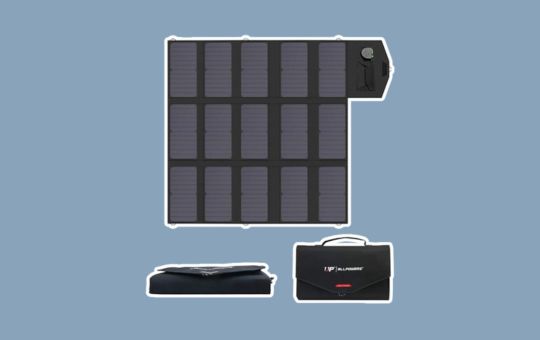
Most of the solar products in this lineup are little maintainers, the kind you toss on a dashboard to keep a battery from dying. The ALLPOWERS 100W panel is a different beast entirely. It’s a foldable, portable solar charger designed not only for keeping 12V vehicle batteries alive but also for powering laptops, tablets, and even small off-grid setups when you’re camping or traveling. Think less “trickle” and more “real charging capability.”
Specs and features:
- 100W foldable monocrystalline solar panel (roughly 20 × 25 inches folded, unfolds to about 40 × 20).
- Dual output ports: 18V DC for 12V batteries and power stations, plus dual 5V USB ports for devices.
- Output: up to 18V/5.4A DC and 5V/2.4A USB (per port).
- Water-resistant polyester fabric with reinforced stitching; not waterproof to full rain exposure.
- Lightweight for its wattage — under 5 lbs — with a carrying handle.
- Designed for laptops, tablets, car and RV batteries, portable power stations, and camping gear.
The standout feature here is portability with real power. Based on reviews, this panel can comfortably charge a laptop in the field, top off a portable power station, or actually put useful charge into a 12V car or RV battery (something a 5–20W maintainer could never do). Users highlight how quick it folds out and how easy it is to stash in a backpack or car trunk.
But with higher output comes a few caveats. One drawback noted in reviews is durability. The folding design relies on fabric hinges and stitching, which aren’t as rugged as framed glass panels. Long-term outdoor exposure, constant rain, and heavy wind aren’t ideal. Some users also noted that the advertised 100W output is rarely achieved; in real-world sunlight, expect closer to 60–80W. That’s common with portable panels, but it’s still worth managing expectations.
Who is this for? According to reviews and comparisons, it’s best for travelers, campers, and RV owners who need portable charging for multiple devices. It’s also a solid choice for people experimenting with small off-grid setups or anyone wanting a versatile solar panel that can handle both electronics and vehicle batteries. It’s less practical for someone who just wants to keep a car battery from dying; a 10W maintainer would be cheaper and simpler.
✅ Pros
- High wattage compared to typical trickle chargers.
- Foldable, lightweight, and easy to carry.
- Can charge laptops, tablets, and portable power stations directly.
- Dual output (USB + DC) makes it versatile for travel.
⚠️ Cons
- Doesn’t consistently hit full 100W in real-world use.
- Fabric design is less rugged than framed glass panels.
- Not fully waterproof, must be sheltered in heavy rain.
- More expensive than lower-wattage maintainers.
Earthava’s take: Compared to smaller maintainers like ECO-WORTHY’s 10W or Renogy’s 10W, the ALLPOWERS 100W is in another league. It’s the kind of panel you take camping or traveling when you want actual usable power for electronics, not just battery preservation. It sits at the crossroads of portability and higher wattage, not a replacement for a full solar system, but far more versatile than the trickle chargers we’ve covered.
Why You Can Trust Our List
We haven’t tested each charger directly, but our picks come from verified customer reviews, expert insights, and product specifications. Our goal is to highlight dependable options that real drivers and outdoor enthusiasts recommend.
Frequently Asked Questions
Why Solar Car Battery Charger is the Best Option?
Most solar-powered chargers charge slowly which is a good thing right? Yes right. You see, when a battery charges too fast, a lot of heat is generated which reduces the shelf life of the battery. In extreme cases, rapid high-voltage charging may cause the battery to explode.
As earlier mentioned, solar chargers use the readily available sun, and you will not need any specialized equipment to charge your battery. This makes charging your battery very easy and convenient. The case is different with an electric charger as you would have to look for a power source to do the charging. Let’s have a look at the 10 best solar car battery chargers.
How do solar car battery chargers work?
Solar car battery chargers, also known as solar battery maintainers, are an innovative and eco-friendly way to keep your car battery charged and extend its lifespan. These chargers harness the power of the sun to provide a continuous trickle charge to your battery. In this blog post, we will explore how solar car battery chargers work and discuss their benefits.
Solar car battery chargers consist of three main components: the solar panel, the charge controller, and the battery itself. The solar panel is the heart of the charger and is responsible for converting sunlight into electricity. It is usually made up of multiple photovoltaic cells, which generate a direct current (DC) when exposed to sunlight.
The charge controller is an essential component that regulates the flow of electricity from the solar panel to the battery. It ensures that the battery is not overcharged or damaged by controlling the voltage and current. Additionally, some charge controllers have built-in features like reverse polarity protection, short circuit protection, and temperature compensation, which further enhance the safety and effectiveness of the charging process.
The battery is the recipient of the solar energy and stores it for later use. In the case of solar car battery chargers, the battery acts as a buffer, absorbing the excess energy from the solar panel during the day and using it to maintain the charge of the car battery. This mechanism prevents the car battery from being completely drained, especially during periods of inactivity or when exposed to extreme weather conditions.
To charge your car battery using a solar charger, you will need to follow these steps:
1. Choose a suitable location: Place the solar panel in an area that receives direct sunlight for the majority of the day. This could be on the dashboard, roof, or windshield of your car.
2. Connect the solar panel: Attach the solar panel to the charge controller using the provided cables. Make sure to connect the positive (+) and negative (-) terminals correctly.
3. Connect the charge controller to the battery: Connect the charge controller to the car battery using the appropriate cables. Again, ensure that the positive and negative terminals are correctly connected.
4. Monitor the charging process: Once everything is connected, the solar charger will start to generate electricity and charge the car battery. You can monitor the charging progress through the charge controller’s display, if available.
5. Maintain regular usage: It is recommended to use your car regularly while the solar charger is connected. This helps to ensure that the battery remains in good condition and is not completely drained.
6. Take precautions during extreme weather: While solar car battery chargers are designed to be weather-resistant, it is still important to protect the charger and battery during severe storms or extreme temperatures. Consider covering the solar panel or moving it to a safer location if necessary.
How long does it take to charge a car battery with a solar charger?
As environmentally-conscious individuals, many of us strive to incorporate sustainable practices into our daily lives. One way we can contribute to a greener future is by utilizing solar power to charge our car batteries. However, the time it takes to charge a car battery with a solar charger can vary based on several factors.
Firstly, the capacity of the solar charger and the size of the car battery play a significant role in determining the charging time. If you have a larger capacity solar charger, it can generate more power and consequently charge your car battery faster. Similarly, a larger car battery will take longer to charge compared to a smaller one.
Additionally, weather conditions and the amount of sunlight available can impact the charging time. On a sunny day, when the solar charger is exposed to direct sunlight, it will generate more electricity and charge the battery at a faster rate. However, on cloudy or overcast days, the charging process may be slower due to reduced sunlight.
In general, it can take several hours to charge a car battery with a solar charger. On average, a 100-watt solar charger can provide around 4 to 5 amps of current per hour. Considering this, a fully discharged car battery with a capacity of 40 amp-hours would require approximately 8 to 10 hours of charging time to reach full capacity. However, it is important to note that these numbers are approximate and can vary depending on the factors mentioned earlier.
To maximize the efficiency of charging your car battery with a solar charger, there are a few additional tips you can follow:
1. Position the solar panel correctly: To ensure maximum sunlight exposure, position the solar panel in a location where it can receive direct sunlight for the majority of the day. Avoid placing it in shaded areas or under coverings that may block the sunlight.
2. Clean the solar panel regularly: Dust, dirt, and debris can accumulate on the surface of the solar panel, reducing its efficiency. Clean the panel regularly with a soft cloth and mild detergent to keep it free from dirt.
3. Use a solar charge controller: A solar charge controller helps regulate the flow of electricity from the solar panel to the battery, preventing overcharging or overheating. This can help protect your car battery and prolong its lifespan.
4. Monitor the charging process: Keep an eye on the charging progress to ensure that the battery is not overcharged or undercharged. Many solar chargers come with built-in indicators or meters that display the charging status.
5. Avoid fully draining the car battery: It is recommended to avoid completely draining your car battery before recharging it with a solar charger. Regularly recharging the battery when it is in a partially discharged state helps maintain its overall health and performance. Consider using a battery maintainer to keep the battery topped up even when the solar charger is not in use.
6. Take precautions during extreme weather: While solar car battery chargers are designed to be weather-resistant, it is still important to protect the charger and battery from extreme weather conditions. In particularly hot weather, it is advisable to provide some shade for the charger to prevent overheating. Similarly, in cold weather, you may want to insulate the battery to maintain its performance.
By following these tips, you can ensure that your car battery is efficiently charged using a solar charger while also prolonging its lifespan. Additionally, using a solar charger is not only eco-friendly but also cost-effective, as it harnesses the power of the sun, a renewable energy source.
What are the Main Features of The Solar Car Battery Charger
1. Prevent Overcharge or Discharge of Your Battery
Any solar car charger worth its salt should come with a mechanism to prevent your battery from overcharging or discharging. Some have a regulator that prevents overcharging. For other brands, you have to set the current that you want to flow into your battery.
2. Ample-sized wires and connectors
You might find yourself in a situation where you need to move the solar panel of your charger a long distance. A charger that comes with long wires and connectors is ideal for such situations. The long wires will enable you to place the panels in the optimum position.
3. High Powered chargers
There are solar power panels that have a high resolution and can convert light to power even in an overcast sky. Ideally, all solar panels can do so, but their power output is greatly reduced. You should buy solar battery chargers that are designed to work in low-light situations.
What are Benefits of The Solar Car Battery Charger
One of the greatest advantages of the solar car battery charger is its portability. You practically move with it wherever you go and can charge your car battery on the move. Another advantage is that the charger does not require an external source of energy, unlike the electric charger. This makes it cheaper since you do not incur additional electricity costs.
With proper usage and maintenance, the charger is guaranteed to give you service for a long period. Since you can use the cigarette port to charge your battery, you need not worry about fixing the alligator clips to the battery terminals- just plug the charger in ad off you go!
Conclusion
The portable solar car battery charger is not only effective, but they are also efficient. The ease of portability and use, it sense to grab one for yourself. With a solar car battery charger, you no longer have to worry about your car not starting due to a low battery.



Great post! Thanks for sharing the knowledge and keep up the good work.